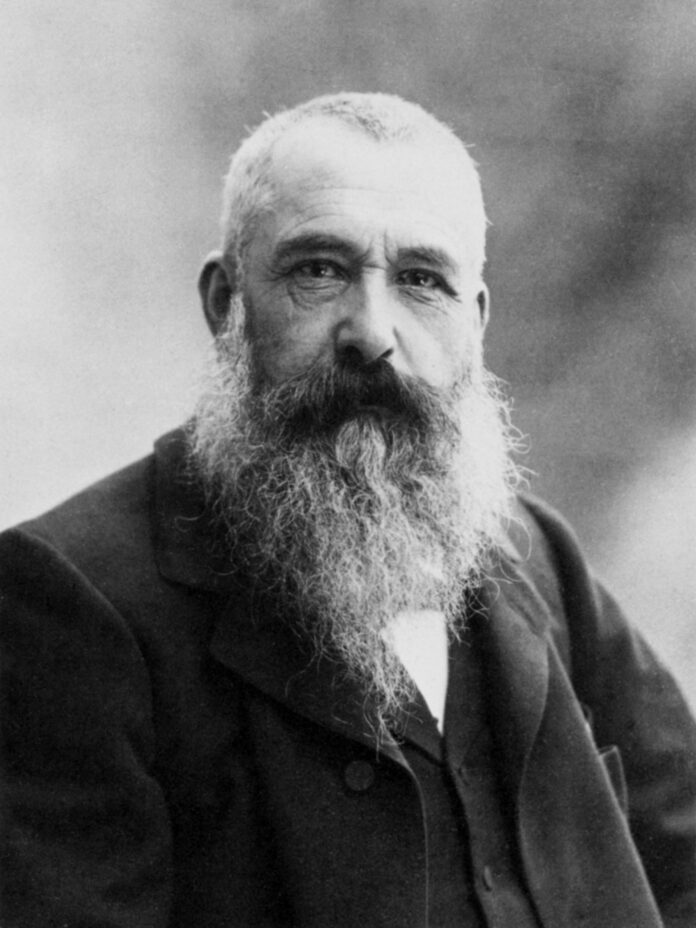If you happened to live in the quaint little town of Giverny sometime in the later half-nineteenth century, you might have come across an old man, with a characteristically flowy salt-pepper beard, swiftly strolling down one of the many cobblestones lanes crisscrossing the town. Accompanying him on his outings were his prized easel and white canvas board, plucked out of a drab studio setting and pitched into a vividly hued natural setting, that became the inspiration for his epoch-defining paintings. Each of his many wondrous paintings was the result of his ability to paint nature which reflected the delicate balance of time and light. Considered a doyen of the French art world, Claude Monet was the demiurge of the Impressionist movement. Monet’s work completely revolutionised art history.

Early years of his life
Oscar Claude Monet, popularly known as Claude Monet, was born on 14 November 1840 in the 9th arrondissement of Paris. He was the second son of Claude Adolphe Monet and Louise Justine Aubrée Monet, both second-generation Parisians. Five years after his birth, the family moved to Le Havre in Normandy, and it was here that Monet spent a substantial part of his childhood and early adulthood. From a very young age, Monet showed a natural skill for art, that became known through his deftly sketched caricatures of his family and acquaintances. Although his mother encouraged her son’s blooming passion for art, his father was opposed to it and instead wanted Monet to follow him into the family trade of ship-chandling.
Even as a young child, Monet held the liveliness of the natural outdoors close to his heart. He would often venture out and spend hours taking in the idyllic radiance of the countryside, which would later be reflected in his paintings. Despite his father’s resistance, he plunged himself into the world of painting. He took his first art lessons from Jacques-François Ochard, a one-time student of Jacques-Louis David. During his artistically nascent years, he came across fellow artist Eugène Boudin, who took Monet under his wings. Boudin regularly took Monet out on outdoor painting excursions and encouraged him to refine his outdoor painting techniques.

Monet continued his art studies at the Académie Suisse, which had been disrupted when he was called to serve in the military wing, Chasseurs d’Afrique in Algeria. His time in the country had a powerful effect on the artist. Monet would later be quoted as saying, “the light and vivid colours of North Africa contained the gem of my future research.” Once again, his time in Algeria was marred by illness forcing him to finish the remainder of his service in France. After his release from the military, Monet returned to Paris and began his apprenticeship in the Swiss artist Charles Gleyre’s studio, where he eventually met fellow Impressionists Pierre-Auguste Renoir and Frédéric Bazille. It was during this period, he painted one of his most popular works, Le déjeuner sur l’herbe, considered to be the most important painting of Monet’s early period. Despite his astounding talent, he constantly relied on the financial support of his well-wishers to run his affairs.
Later years of his life
To avoid being conscripted into the army during the onset of the Franco-Prussian War, Monet moved to England. While living in London, he met his potential art dealer Paul Durand-Ruel, an encounter that heralded more visibility for his work. His time there also brought him in contact with British artist J.M.W Turner’s works. Monet admired Turner’s brilliant ability to delicately capture light. Most notably, he was in awe of Turner’s work depicting the morning mist gently floating over the Thames. This fuelled his passion for producing work that captured different points of view in a natural outdoor setting. His favourites were working with shimmering reflections in the water, and rays of sunshine piercing through tree canopies. Upon his return to Paris, after the self-imposed exile, he even acquired a sailboat to set up a floating studio on the river Sienne to replicate Turner’s style.

Over time, Durand-Ruel’s support of Monet and his peers began to wane. As a result, these artists grouped themselves to showcase their art independently, earning a reputation for deploying artistic techniques that didn’t align with the mainstream art world. At one of the earliest exhibitions of the group’s works, Monet displayed, among others, Impression, Sunrise, The Luncheon and Boulevard des Capucines. It opened the hostile public reviews, with art critic Louis Leroy taking particular notice of Impression, Sunrise (1872), a hazy depiction of Le Havre port and stylistic detour, condescendingly terming it “Impressionism”. Though he regretted it later, Leroy had inadvertently given name to an incipient art movement that dramatically transformed the nineteenth-century art world. Despite continued public disapproval, Monet and his fellow impressionist artists continued to produce evocative artworks, that dazzle to this day.

As he approached old age, Monet began living in Giverny, where he purchased a dainty cottage nestled in the bucolic country landscape. Here, he cultivated his garden supplemented with a water-lily pond, that inspired several of his last known works. His paintings of the water lilies in his garden itself occupied him continuously for the last thirty years of his life.
Monet died of lung cancer on 5 December 1926 at the ripe old age of 86, leaving a rich artistic legacy that will forever remain unmatched.

Monet’s most consequential work: Water Lillies
Water Lilies is one of Claude Monet’s best paintings, so enamoured was he with them that by the time of his death, Monet had a gigantic collection of water lilies paintings, constituting around 250 paintings in all. Many of the works were painted while Monet suffered from severe cataracts. In 1893, after settling down in Giverny, Monet bought a piece of land in front of his cottage. Here, he decided to create a Japanese-style minimalist flower garden featuring a pond brimming with water lilies. Secluded from the outside world, he conjured up the most exquisitely crafted pieces of art. His works have sold for jaw-dropping prices, with Meules (Haystacks), becoming the first painting from the Impressionist movement to surpass $100 million. Today, the paintings are displayed at museums all over the world, with a sizable chunk of them available for viewing at the Musée de l’Orangerie in Paris.





